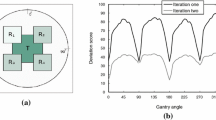Abstract
Algorithms are an essential part of radiation therapy planning, which includes three optimizations problems: beam angle configuration, fluence map, and realization. This study addresses the third one, also called the leaf sequencing problem, which arises for each chosen irradiation angle, given the optimized fluence map. It consists in defining a sequence of configurations of a device (called multileaf collimator) that correctly delivers radiation to the patient. A usual model for this problem is the decomposition of a matrix into a weighted sum of (0,1)-matrices, called segments, in which the ones in each row appear consecutively. Each (0,1)-matrix corresponds to a configuration of the device. The realization problem has three objectives. The first one is to minimize the sum of weights assigned to the (0,1)-matrices. The second is to minimize the number of segments. Finally, the third one is to find the best order to apply those configurations. This study presents a greedy and randomized algorithm to this problem and compares it with other algorithms presented previously in the literature. Statistical tests show that our algorithm outperformed the previous ones regarding the quality indicators investigated.

a Illustrates how the IMRT realization is modelled to a mathematical problem. b Shows a decomposition example of the IMRT realization. c The scheme of the algorithm that is proposed on this work, called GRA-SRA.


Similar content being viewed by others
References
Baatar D, Hamacher HW, Ehrgott M, Woeginger GJ (2005) Decomposition of integer matrices and multileaf collimator sequencing. Discret Appl Math 152:6–34
Bortfeld TR, Kahler DL, Waldron TJ, Boyer AL (1994) X-ray field compensation with multileaf collimators. Int J Radiat Oncol Biol Phys 28(3):723–730
Cambazard H, O’Mahony E, O’Sullivan B (2012) A shortest path-based approach to the multileaf collimator sequencing problem. Discret Appl Math 160(1):81–99
Catanzaro D, Engelbeen C (2015) An integer linear programming formulation for the minimum cardinality segmentation problem. Algorithms 8:999–1020
Croes A (1958) A method for solving traveling salesman problems. Oper Res 5:791–812
Ehrgott M (2005) Multicriteria optimization. Springer, Berlin
Ehrgott M, Güler Ç, Hamacher HW, Shao L (2010) Mathematical optimization in intensity modulated radiation therapy. Ann Oper Res 175(1):309–365
Engel K (2005) A new algorithm for optimal multileaf collimator field segmentation. Discret Appl Math 152(1):35–51
Ernst A, Mak-Hau V, Mason LR (2009) An exact method for the minimum cardinality problem in the treatment planning of intensity-modulated radiotherapy. INFORMS J Comput 21:562–574, 11
Friedman M (1937) The use of ranks to avoid the assumption of normality implicit in the analysis of variance. J Am Stat Assoc 32(200):675–701
Galvin JM (1999) The multileaf collimator-a complete guide. In: Proceedings of the annual meeting of the AAPM
Galvin JM, Chen X-G, Smith RM (1993) Combining multileaf fields to modulate fluence distributions. Int J Radiat Oncol—Biol Phys 27(3):697–705
Garey MR, Johnson DS (1990) Computers and intractability; a guide to the theory of NP-completeness. W. H. Freeman & Co., New York
Gunderson L, Tepper J (2011) Clinical radiation oncology: third edition. Elsevier Inc. 10
Hansen P, Mladenović N (2006) First vs. best improvement: an empirical study. Discret Appl Math 154(5):802–817. IV ALIO/EURO Workshop on Applied Combinatorial Optimization
Helsgaun K (2000) An effective implementation of the lin-kernighan traveling salesman heuristic. Eur J Oper Res 126:106–130
Hollander M, Wolfe D (1999) Nonparametric statistical methods. Wiley series in probability and statistics. Wiley, New York
Kalinowski T (2005) A duality based algorithm for multileaf collimator field segmentation with interleaf collision constraint. Discret Appl Math 152:52–88
Kalinowski T (2006) Realization of intensity modulated radiation fields using multileaf collimators. In: General theory of information transfer and combinatorics, chapter 1. Springer, Berlin, pp 1010–1055
Lin S, Kernighan BW (1973) An effective heuristic algorithm for the travelling-salesman problem. Oper Res 21:498–516
Lust T, Teghem J (2009) Multiobjective decomposition of integer matrices: application to radiotherapy. In: Ehrgott M, Fonseca C, Gandibleux X, Hao JK, Sevaux M (eds) EMO 2009 evolutionary multi-criterion optimization. Springer, Berlin, pp 335–349
Paquete L, Chiarandini M, Stützle T (2004) Pareto local optimum sets in the biobjective traveling salesman problem: an experimental study. In: Gandibleux X, Sevaux M, Sörensen K, T’kindt V (eds) Metaheuristics for multiobjective optimisation. Springer, Berlin, pp 177–199
Xia P, Verhey LJ (1998) Multileaf collimator leaf sequencing algorithm for intensity modulated beams with multiple static segments. Med Phys 25(8):1424–1434
Author information
Authors and Affiliations
Corresponding author
Additional information
Publisher’s note
Springer Nature remains neutral with regard to jurisdictional claims in published maps and institutional affiliations.
Rights and permissions
About this article
Cite this article
Medeiros, H., Goldbarg, E.F.G. & Goldbarg, M.C. On the three-objective static unconstrained leaf sequencing in IMRT. Med Biol Eng Comput 58, 2025–2037 (2020). https://doi.org/10.1007/s11517-020-02210-z
Received:
Accepted:
Published:
Issue Date:
DOI: https://doi.org/10.1007/s11517-020-02210-z




